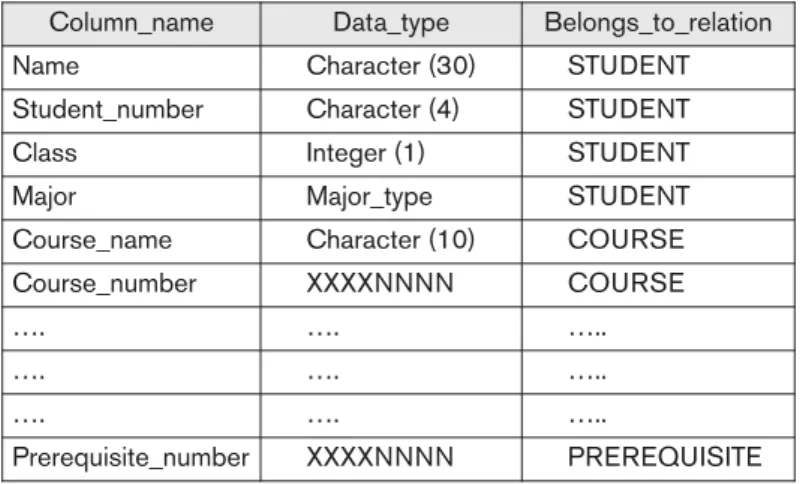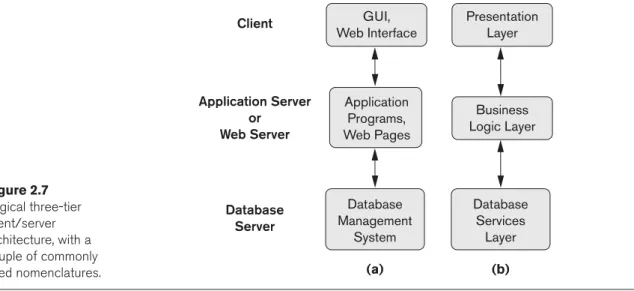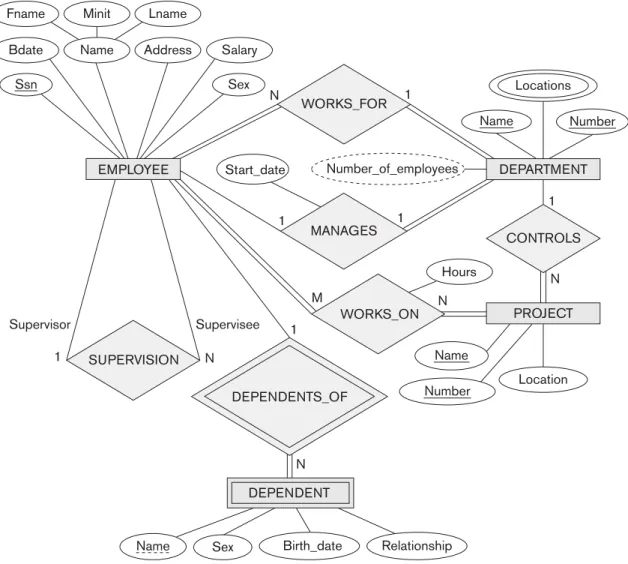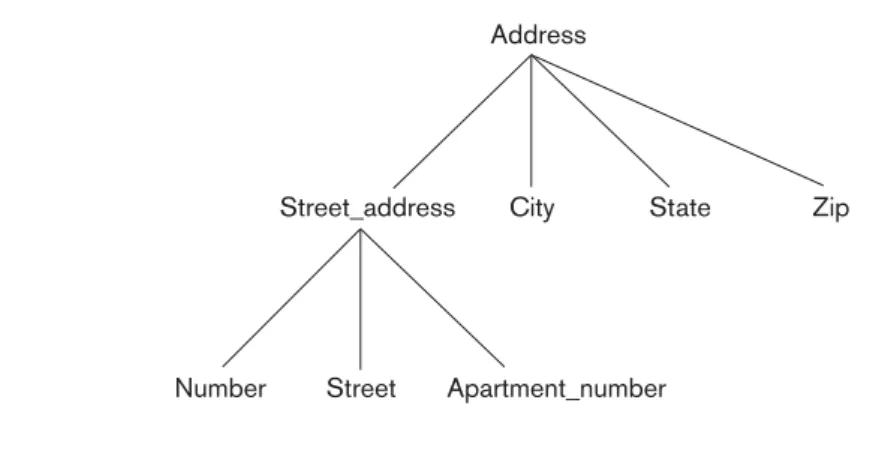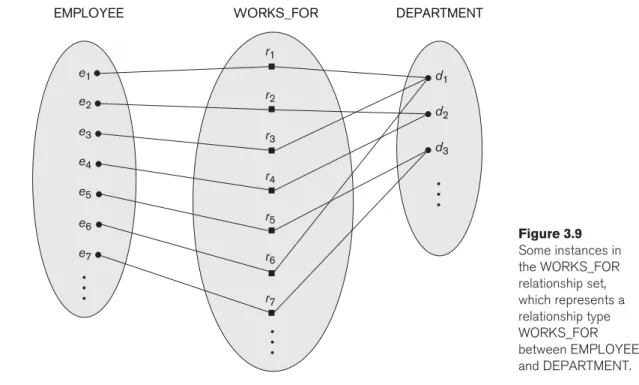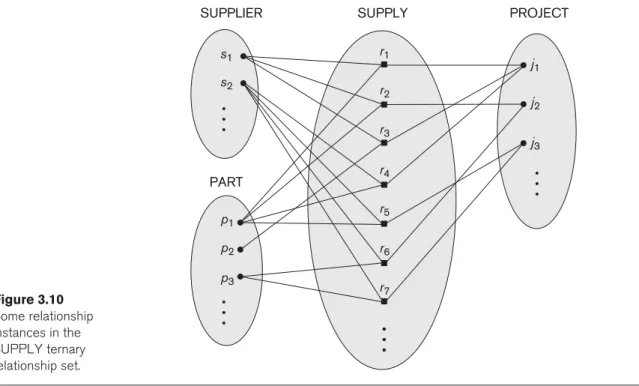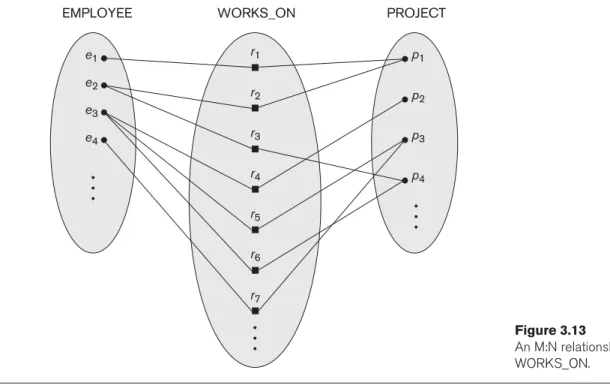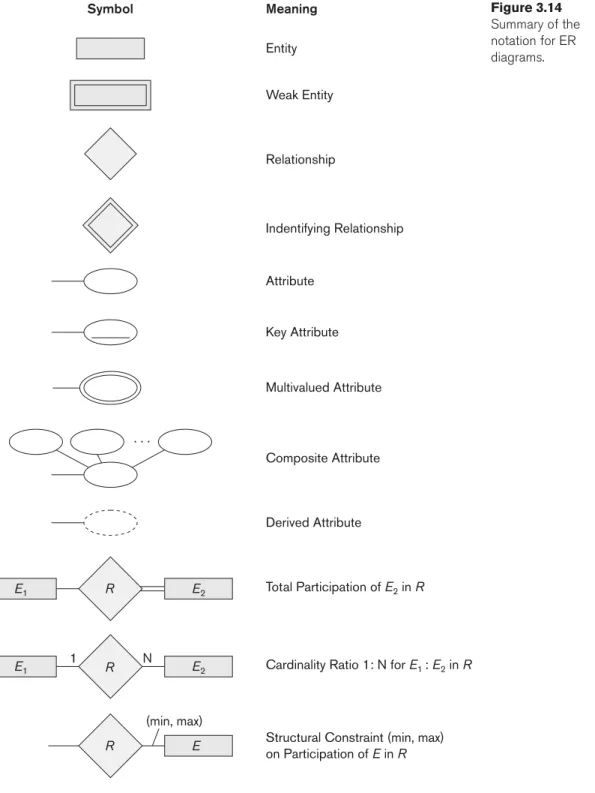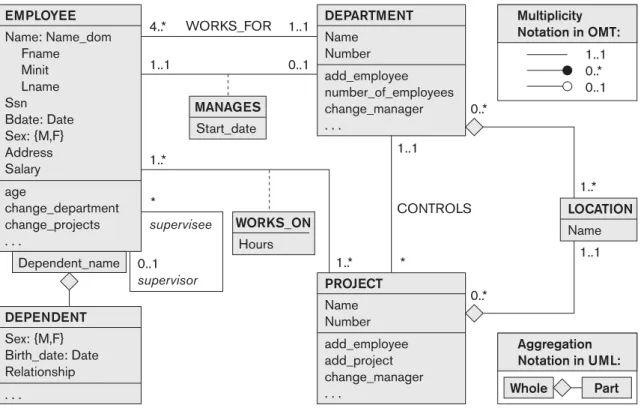FUNDAMENTALS OF
Database Systems
SEVENTH EDITION
FUNDAMENTALS OF
Database Systems
SEVENTH EDITION
Ramez Elmasri
Department of Computer Science and Engineering The University of Texas at Arlington
Shamkant B. Navathe College of Computing
Georgia Institute of Technology
Boston Columbus Indianapolis New York San Francisco Hoboken
Amsterdam Cape Town Dubai London Madrid Milan Munich Paris Montreal Toronto Delhi Mexico City São Paulo Sydney Hong Kong Seoul Singapore Taipei Tokyo
Acquisitions Editor: Matt Goldstein Editorial Assistant: Kelsey Loanes
Marketing Managers: Bram Van Kempen, Demetrius Hall Marketing Assistant: Jon Bryant
Senior Managing Editor: Scott Disanno Production Project Manager: Rose Kernan Program Manager: Carole Snyder Global HE Director of Vendor Sourcing and Procurement: Diane Hynes Director of Operations: Nick Sklitsis
Manager, Rights and Permissions: Rachel Youdelman Associate Project Manager, Rights and Permissions:
Timothy Nicholls
Full-Service Project Management: Rashmi Tickyani, iEnergizer Aptara®, Ltd.
Composition: iEnergizer Aptara®, Ltd.
Printer/Binder: Edwards Brothers Malloy Cover Printer: Phoenix Color/Hagerstown Cover Image: Micha Pawlitzki/Terra/Corbis Typeface: 10.5/12 Minion Pro
ISBN-10: 0-13-397077-9 ISBN-13: 978-0-13-397077-7 Copyright © 2016, 2011, 2007 by Ramez Elmasri and Shamkant B. Navathe. All rights reserved. Manufactured in the United States of America. This publication is protected by Copyright and permissions should be obtained from the publisher prior to any prohibited reproduction, storage in a retrieval system, or transmission in any form or by any means, electronic, mechanical, photocopying, recording, or likewise. To obtain permission(s) to use materials from this work, please submit a written request to Pearson Higher Education, Permissions Department, 221 River Street, Hoboken, NJ 07030.
Many of the designations by manufacturers and seller to distinguish their products are claimed as trademarks.
Where those designations appear in this book, and the publisher was aware of a trademark claim, the designations have been printed in initial caps or all caps.
The author and publisher of this book have used their best efforts in preparing this book. These efforts include the development, research, and testing of theories and programs to determine their effectiveness. The author and publisher make no warranty of any kind, expressed or implied, with regard to these programs or the documentation contained in this book. The author and publisher shall not be liable in any event for incidental or consequential damages with, or arising out of, the furnishing, performance, or use of these programs.
Microsoft and/or its respective suppliers make no representations about the suitability of the information contained in the documents and related graphics published as part of the services for any purpose. All such documents and related graphics are provided “as is” without warranty of any kind. Microsoft and/or its respective suppliers hereby disclaim all warranties and conditions with regard to this information, including all warranties and conditions of merchantability. Whether express, implied or statutory, fitness for a particular purpose, title and non-infringement. In no event shall microsoft and/or its respective suppliers be liable for any special, indirect or consequential damages or any damages whatsoever resulting from loss of use, data or profits, whether in an action of contract. Negligence or other tortious action, arising out of or in connection with the use or performance of information available from the services.
The documents and related graphics contained herein could include technical inaccuracies or typographical errors. Changes are periodically added to the information herein. Microsoft and/or its respective suppliers may make improvements and/or changes in the product(s) and/or the program(s) described herein at any time.
Partial screen shots may be viewed in full within the software version specified.
Library of Congress Cataloging-in-Publication Data on File
10 9 8 7 6 5 4 3 2 1
To Amalia and
to Ramy, Riyad, Katrina, and Thomas R. E.
To my wife Aruna for her love, support, and understanding and
to Rohan, Maya, and Ayush for bringing so much joy into our lives S.B.N.
T
his book introduces the fundamental concepts necessary for designing, using, and implementing database systems and database applications. Our presentation stresses the funda- mentals of database modeling and design, the languages and models provided by the database management systems, and database system implementation techniques.The book is meant to be used as a textbook for a one- or two-semester course in database systems at the junior, senior, or graduate level, and as a reference book. Our goal is to provide an in-depth and up-to-date presentation of the most important aspects of database systems and applications, and related technologies. We assume that readers are familiar with elementary programming and data-structuring con- cepts and that they have had some exposure to the basics of computer organization.
New to This Edition
The following key features have been added in the seventh edition:
■ A reorganization of the chapter ordering (this was based on a survey of the instructors who use the textbook); however, the book is still organized so that the individual instructor can choose to follow the new chapter ordering or choose a different ordering of chapters (for example, follow the chapter order from the sixth edition) when presenting the materials.
■ There are two new chapters on recent advances in database systems and big data processing; one new chapter (Chapter 24) covers an introduction to the newer class of database systems known as NOSQL databases, and the other new chapter (Chapter 25) covers technologies for processing big data, including MapReduce and Hadoop.
■ The chapter on query processing and optimization has been expanded and reorganized into two chapters; Chapter 18 focuses on strategies and algo- rithms for query processing whereas Chapter 19 focuses on query optimiza- tion techniques.
■ A second UNIVERSITY database example has been added to the early chap- ters (Chapters 3 through 8) in addition to our COMPANY database example from the previous editions.
■ Many of the individual chapters have been updated to varying degrees to include newer techniques and methods; rather than discuss these enhancements here,
Preface
vii
we will describe them later in the preface when we discuss the organization of the seventh edition.
The following are key features of the book:
■ A self-contained, flexible organization that can be tailored to individual needs; in particular, the chapters can be used in different orders depending on the instructor’s preference.
■ A companion website (http://www.pearsonhighered.com/cs-resources) includes data to be loaded into various types of relational databases for more realistic student laboratory exercises.
■ A dependency chart (shown later in this preface) to show which chapters depend on other earlier chapters; this can guide the instructor who wants to tailor the order of presentation of the chapters.
■ A collection of supplements, including a robust set of materials for instruc- tors and students such as PowerPoint slides, figures from the text, and an instructor’s guide with solutions.
Organization and Contents of the Seventh Edition
There are some organizational changes in the seventh edition as well as improve- ment to the individual chapters. The book is now divided into 12 parts as follows:
■ Part 1 (Chapters 1 and 2) describes the basic introductory concepts neces- sary for a good understanding of database models, systems, and languages.
Chapters 1 and 2 introduce databases, typical users, and DBMS concepts, terminology, and architecture, as well as a discussion of the progression of database technologies over time and a brief history of data models. These chapters have been updated to introduce some of the newer technologies such as NOSQL systems.
■ Part 2 (Chapters 3 and 4) includes the presentation on entity-relationship modeling and database design; however, it is important to note that instruc- tors can cover the relational model chapters (Chapters 5 through 8) before Chapters 3 and 4 if that is their preferred order of presenting the course materials. In Chapter 3, the concepts of the Entity-Relationship (ER) model and ER diagrams are presented and used to illustrate conceptual database design. Chapter 4 shows how the basic ER model can be extended to incorpo- rate additional modeling concepts such as subclasses, specialization, gener- alization, union types (categories) and inheritance, leading to the enhanced-ER (EER) data model and EER diagrams. The notation for the class diagrams of UML are also introduced in Chapters 7 and 8 as an alternative model and diagrammatic notation for ER/EER diagrams.
■ Part 3 (Chapters 5 through 8) includes a detailed presentation on relational databases and SQL with some additional new material in the SQL chapters to cover a few SQL constructs that were not in the previous edition. Chapter 5
Preface ix
describes the basic relational model, its integrity constraints, and update operations. Chapter 6 describes some of the basic parts of the SQL standard for relational databases, including data definition, data modification opera- tions, and simple SQL queries. Chapter 7 presents more complex SQL que- ries, as well as the SQL concepts of triggers, assertions, views, and schema modification. Chapter 8 describes the formal operations of the relational algebra and introduces the relational calculus. The material on SQL (Chap- ters 6 and 7) is presented before our presentation on relational algebra and calculus in Chapter 8 to allow instructors to start SQL projects early in a course if they wish (it is possible to cover Chapter 8 before Chapters 6 and 7 if the instructor desires this order). The final chapter in Part 2, Chapter 9, covers ER- and EER-to-relational mapping, which are algorithms that can be used for designing a relational database schema from a conceptual ER/EER schema design.
■ Part 4 (Chapters 10 and 11) are the chapters on database programming tech- niques; these chapters can be assigned as reading materials and augmented with materials on the particular language used in the course for program- ming projects (much of this documentation is readily available on the Web).
Chapter 10 covers traditional SQL programming topics, such as embedded SQL, dynamic SQL, ODBC, SQLJ, JDBC, and SQL/CLI. Chapter 11 introduces Web database programming, using the PHP scripting language in our exam- ples, and includes new material that discusses Java technologies for Web database programming.
■ Part 5 (Chapters 12 and 13) covers the updated material on object-relational and object-oriented databases (Chapter 12) and XML (Chapter 13); both of these chapters now include a presentation of how the SQL standard incorpo- rates object concepts and XML concepts into more recent versions of the SQL standard. Chapter 12 first introduces the concepts for object databases, and then shows how they have been incorporated into the SQL standard in order to add object capabilities to relational database systems. It then covers the ODMG object model standard, and its object definition and query lan- guages. Chapter 13 covers the XML (eXtensible Markup Language) model and languages, and discusses how XML is related to database systems. It presents XML concepts and languages, and compares the XML model to traditional database models. We also show how data can be converted between the XML and relational representations, and the SQL commands for extracting XML documents from relational tables.
■ Part 6 (Chapters 14 and 15) are the normalization and relational design theory chapters (we moved all the formal aspects of normalization algo- rithms to Chapter 15). Chapter 14 defines functional dependencies, and the normal forms that are based on functional dependencies. Chapter 14 also develops a step-by-step intuitive normalization approach, and includes the definitions of multivalued dependencies and join dependencies.
Chapter 15 covers normalization theory, and the formalisms, theories,
and algorithms developed for relational database design by normaliza- tion, including the relational decomposition algorithms and the relational synthesis algorithms.
■ Part 7 (Chapters 16 and 17) contains the chapters on file organizations on disk (Chapter 16) and indexing of database files (Chapter 17). Chapter 16 describes primary methods of organizing files of records on disk, including ordered (sorted), unordered (heap), and hashed files; both static and dynamic hashing techniques for disk files are covered. Chapter 16 has been updated to include materials on buffer management strategies for DBMSs as well as an overview of new storage devices and standards for files and mod- ern storage architectures. Chapter 17 describes indexing techniques for files, including B-tree and B+-tree data structures and grid files, and has been updated with new examples and an enhanced discussion on indexing, including how to choose appropriate indexes and index creation during physical design.
■ Part 8 (Chapters 18 and 19) includes the chapters on query processing algo- rithms (Chapter 18) and optimization techniques (Chapter 19); these two chapters have been updated and reorganized from the single chapter that covered both topics in the previous editions and include some of the newer techniques that are used in commercial DBMSs. Chapter 18 presents algo- rithms for searching for records on disk files, and for joining records from two files (tables), as well as for other relational operations. Chapter 18 con- tains new material, including a discussion of the semi-join and anti-join operations with examples of how they are used in query processing, as well as a discussion of techniques for selectivity estimation. Chapter 19 covers techniques for query optimization using cost estimation and heuristic rules;
it includes new material on nested subquery optimization, use of histograms, physical optimization, and join ordering methods and optimization of typical queries in data warehouses.
■ Part 9 (Chapters 20, 21, and 22) covers transaction processing concepts;
concurrency control; and database recovery from failures. These chapters have been updated to include some of the newer techniques that are used in some commercial and open source DBMSs. Chapter 20 introduces the techniques needed for transaction processing systems, and defines the concepts of recoverability and serializability of schedules; it has a new sec- tion on buffer replacement policies for DBMSs and a new discussion on the concept of snapshot isolation. Chapter 21 gives an overview of the var- ious types of concurrency control protocols, with a focus on two-phase locking. We also discuss timestamp ordering and optimistic concurrency control techniques, as well as multiple-granularity locking. Chapter 21 includes a new presentation of concurrency control methods that are based on the snapshot isolation concept. Finally, Chapter 23 focuses on database recovery protocols, and gives an overview of the concepts and techniques that are used in recovery.
■ Part 10 (Chapters 23, 24, and 25) includes the chapter on distributed data- bases (Chapter 23), plus the two new chapters on NOSQL storage systems for big data (Chapter 24) and big data technologies based on Hadoop and MapReduce (Chapter 25). Chapter 23 introduces distributed database concepts, including availability and scalability, replication and fragmenta- tion of data, maintaining data consistency among replicas, and many other concepts and techniques. In Chapter 24, NOSQL systems are categorized into four general categories with an example system in each category used for our examples, and the data models, operations, as well as the replica- tion/distribution/scalability strategies of each type of NOSQL system are discussed and compared. In Chapter 25, the MapReduce programming model for distributed processing of big data is introduced, and then we have presentations of the Hadoop system and HDFS (Hadoop Distributed File System), as well as the Pig and Hive high-level interfaces, and the YARN architecture.
■ Part 11 (Chapters 26 through 29) is entitled Advanced Database Models, Systems, and Applications and includes the following materials: Chapter 26 introduces several advanced data models including active data- bases/triggers (Section 26.1), temporal databases (Section 26.2), spatial data- bases (Section 26.3), multimedia databases (Section 26.4), and deductive databases (Section 26.5). Chapter 27 discusses information retrieval (IR) and Web search, and includes topics such as IR and keyword-based search, comparing DB with IR, retrieval models, search evaluation, and ranking algorithms. Chapter 28 is an introduction to data mining including over- views of various data mining methods such as associate rule mining, cluster- ing, classification, and sequential pattern discovery. Chapter 29 is an overview of data warehousing including topics such as data warehousing models and operations, and the process of building a data warehouse.
■ Part 12 (Chapter 30) includes one chapter on database security, which includes a discussion of SQL commands for discretionary access control (GRANT, REVOKE), as well as mandatory security levels and models for including mandatory access control in relational databases, and a discussion of threats such as SQL injection attacks, as well as other techniques and methods related to data security and privacy.
Appendix A gives a number of alternative diagrammatic notations for displaying a conceptual ER or EER schema. These may be substituted for the notation we use, if the instructor prefers. Appendix B gives some important physical parameters of disks. Appendix C gives an overview of the QBE graphical query language, and Appendixes D and E (available on the book’s Companion Website located at http://www.pearsonhighered.com/elmasri) cover legacy database systems, based on the hierarchical and network database models. They have been used for more than thirty years as a basis for many commercial database applications and transaction- processing systems.
Preface xi
Guidelines for Using This Book
There are many different ways to teach a database course. The chapters in Parts 1 through 7 can be used in an introductory course on database systems in the order that they are given or in the preferred order of individual instructors. Selected chap- ters and sections may be left out and the instructor can add other chapters from the rest of the book, depending on the emphasis of the course. At the end of the open- ing section of some of the book’s chapters, we list sections that are candidates for being left out whenever a less-detailed discussion of the topic is desired. We suggest covering up to Chapter 15 in an introductory database course and including selected parts of other chapters, depending on the background of the students and the desired coverage. For an emphasis on system implementation techniques, chapters from Parts 7, 8, and 9 should replace some of the earlier chapters.
Chapters 3 and 4, which cover conceptual modeling using the ER and EER models, are important for a good conceptual understanding of databases. However, they may be partially covered, covered later in a course, or even left out if the emphasis is on DBMS implementation. Chapters 16 and 17 on file organizations and indexing may also be covered early, later, or even left out if the emphasis is on database mod- els and languages. For students who have completed a course on file organization, parts of these chapters can be assigned as reading material or some exercises can be assigned as a review for these concepts.
If the emphasis of a course is on database design, then the instructor should cover Chapters 3 and 4 early on, followed by the presentation of relational databases. A total life-cycle database design and implementation project would cover conceptual design (Chapters 3 and 4), relational databases (Chapters 5, 6, and 7), data model mapping (Chapter 9), normalization (Chapter 14), and application programs implementation with SQL (Chapter 10). Chapter 11 also should be covered if the emphasis is on Web database programming and applications. Additional documen- tation on the specific programming languages and RDBMS used would be required.
The book is written so that it is possible to cover topics in various sequences. The following chapter dependency chart shows the major dependencies among chap- ters. As the diagram illustrates, it is possible to start with several different topics following the first two introductory chapters. Although the chart may seem com- plex, it is important to note that if the chapters are covered in order, the dependen- cies are not lost. The chart can be consulted by instructors wishing to use an alternative order of presentation.
For a one-semester course based on this book, selected chapters can be assigned as reading material. The book also can be used for a two-semester course sequence.
The first course, Introduction to Database Design and Database Systems, at the sophomore, junior, or senior level, can cover most of Chapters 1 through 15. The second course, Database Models and Implementation Techniques, at the senior or first-year graduate level, can cover most of Chapters 16 through 30. The two- semester sequence can also be designed in various other ways, depending on the preferences of the instructors.
Supplemental Materials
Support material is available to qualified instructors at Pearson’s instructor resource center (http://www.pearsonhighered.com/irc). For access, contact your local Pearson representative.
■ PowerPoint lecture notes and figures.
■ A solutions manual.
Acknowledgments
It is a great pleasure to acknowledge the assistance and contributions of many indi- viduals to this effort. First, we would like to thank our editor, Matt Goldstein, for his guidance, encouragement, and support. We would like to acknowledge the excellent work of Rose Kernan for production management, Patricia Daly for a
1, 2 Introductory
3, 4 ER, EER
Models
5 Relational
Model 8
Relational Algebra
9 ER-, EER-to-
Relational
16, 17 File Organization,
Indexing
28, 29 Data Mining, Warehousing
10, 11 DB, Web Programming
30 DB Security 14, 15
FD, MVD, Normalization
23, 24, 25 DDB, NOSQL,
Big Data 20, 21, 22 Transactions, CC, Recovery
12, 13 ODB, ORDB,
XML
26, 27 Advanced Models, IR 6, 7 SQL
18, 19 Query Processing,
Optimization
Preface xiii
thorough copy editing of the book, Martha McMaster for her diligence in proofing the pages, and Scott Disanno, Managing Editor of the production team. We also wish to thank Kelsey Loanes from Pearson for her continued help with the project, and reviewers Michael Doherty, Deborah Dunn, Imad Rahal, Karen Davis, Gilliean Lee, Leo Mark, Monisha Pulimood, Hassan Reza, Susan Vrbsky, Li Da Xu, Weining Zhang and Vincent Oria.
Ramez Elmasri would like to thank Kulsawasd Jitkajornwanich, Vivek Sharma, and Surya Swaminathan for their help with preparing some of the material in Chap- ter 24. Sham Navathe would like to acknowledge the following individuals who helped in critically reviewing and revising various topics. Dan Forsythe and Satish Damle for discussion of storage systems; Rafi Ahmed for detailed re-organization of the material on query processing and optimization; Harish Butani, Balaji Palanisamy, and Prajakta Kalmegh for their help with the Hadoop and MapReduce technology material; Vic Ghorpadey and Nenad Jukic for revision of the Data Warehousing material; and finally, Frank Rietta for newer techniques in database security, Kunal Malhotra for various discussions, and Saurav Sahay for advances in information retrieval systems.
We would like to repeat our thanks to those who have reviewed and contributed to previous editions of Fundamentals of Database Systems.
■ First edition. Alan Apt (editor), Don Batory, Scott Downing, Dennis Heimbinger, Julia Hodges, Yannis Ioannidis, Jim Larson, Per-Ake Larson, Dennis McLeod, Rahul Patel, Nicholas Roussopoulos, David Stemple, Michael Stonebraker, Frank Tompa, and Kyu-Young Whang.
■ Second edition. Dan Joraanstad (editor), Rafi Ahmed, Antonio Albano, David Beech, Jose Blakeley, Panos Chrysanthis, Suzanne Dietrich, Vic Ghorpadey, Goetz Graefe, Eric Hanson, Junguk L. Kim, Roger King, Vram Kouramajian, Vijay Kumar, John Lowther, Sanjay Manchanda, Toshimi Minoura, Inderpal Mumick, Ed Omiecinski, Girish Pathak, Raghu Ramakrishnan, Ed Robertson, Eugene Sheng, David Stotts, Marianne Winslett, and Stan Zdonick.
■ Third edition. Maite Suarez-Rivas and Katherine Harutunian (editors);
Suzanne Dietrich, Ed Omiecinski, Rafi Ahmed, Francois Bancilhon, Jose Blakeley, Rick Cattell, Ann Chervenak, David W. Embley, Henry A. Etlinger, Leonidas Fegaras, Dan Forsyth, Farshad Fotouhi, Michael Franklin, Sreejith Gopinath, Goetz Craefe, Richard Hull, Sushil Jajodia, Ramesh K. Karne, Harish Kotbagi, Vijay Kumar, Tarcisio Lima, Ramon A. Mata-Toledo, Jack McCaw, Dennis McLeod, Rokia Missaoui, Magdi Morsi, M. Narayanaswamy, Carlos Ordonez, Joan Peckham, Betty Salzberg, Ming-Chien Shan, Junping Sun, Rajshekhar Sunderraman, Aravindan Veerasamy, and Emilia E. Villareal.
■ Fourth edition. Maite Suarez-Rivas, Katherine Harutunian, Daniel Rausch, and Juliet Silveri (editors); Phil Bernhard, Zhengxin Chen, Jan Chomicki, Hakan Ferhatosmanoglu, Len Fisk, William Hankley, Ali R. Hurson, Vijay Kumar, Peretz Shoval, Jason T. L. Wang (reviewers); Ed Omiecinski (who contributed to Chapter 27). Contributors from the University of Texas at
Arlington are Jack Fu, Hyoil Han, Babak Hojabri, Charley Li, Ande Swathi, and Steven Wu; Contributors from Georgia Tech are Weimin Feng, Dan For- sythe, Angshuman Guin, Abrar Ul-Haque, Bin Liu, Ying Liu, Wanxia Xie, and Waigen Yee.
■ Fifth edition. Matt Goldstein and Katherine Harutunian (editors); Michelle Brown, Gillian Hall, Patty Mahtani, Maite Suarez-Rivas, Bethany Tidd, and Joyce Cosentino Wells (from Addison-Wesley); Hani Abu-Salem, Jamal R.
Alsabbagh, Ramzi Bualuan, Soon Chung, Sumali Conlon, Hasan Davulcu, James Geller, Le Gruenwald, Latifur Khan, Herman Lam, Byung S. Lee, Donald Sanderson, Jamil Saquer, Costas Tsatsoulis, and Jack C. Wileden (reviewers); Raj Sunderraman (who contributed the laboratory projects);
Salman Azar (who contributed some new exercises); Gaurav Bhatia, Fari- borz Farahmand, Ying Liu, Ed Omiecinski, Nalini Polavarapu, Liora Sahar, Saurav Sahay, and Wanxia Xie (from Georgia Tech).
■ Sixth edition. Matt Goldstein (editor); Gillian Hall (production manage- ment); Rebecca Greenberg (copy editing); Jeff Holcomb, Marilyn Lloyd, Margaret Waples, and Chelsea Bell (from Pearson); Rafi Ahmed, Venu Dasigi, Neha Deodhar, Fariborz Farahmand, Hariprasad Kumar, Leo Mark, Ed Omiecinski, Balaji Palanisamy, Nalini Polavarapu, Parimala R. Pranesh, Bharath Rengarajan, Liora Sahar, Saurav Sahay, Narsi Srinivasan, and Wanxia Xie.
Last, but not least, we gratefully acknowledge the support, encouragement, and patience of our families.
R. E.
S.B.N.
Preface xv
Contents
Preface vii
About the Authors xxx
■ part 1
Introduction to Databases ■
chapter 1 Databases and Database Users 3
1.1 Introduction 4 1.2 An Example 6
1.3 Characteristics of the Database Approach 10 1.4 Actors on the Scene 15
1.5 Workers behind the Scene 17
1.6 Advantages of Using the DBMS Approach 17 1.7 A Brief History of Database Applications 23 1.8 When Not to Use a DBMS 27
1.9 Summary 27 Review Questions 28 Exercises 28
Selected Bibliography 29
chapter 2 Database System Concepts and Architecture 31
2.1 Data Models, Schemas, and Instances 32
2.2 Three-Schema Architecture and Data Independence 36 2.3 Database Languages and Interfaces 38
2.4 The Database System Environment 42
2.5 Centralized and Client/Server Architectures for DBMSs 46 2.6 Classification of Database Management Systems 51 2.7 Summary 54
Review Questions 55 Exercises 55
Selected Bibliography 56
xvii
■ part 2
Conceptual Data Modeling and Database Design ■ chapter 3 Data Modeling Using the Entity–Relationship (ER)
Model 59
3.1 Using High-Level Conceptual Data Models for Database Design 60
3.2 A Sample Database Application 62
3.3 Entity Types, Entity Sets, Attributes, and Keys 63
3.4 Relationship Types, Relationship Sets, Roles, and Structural Constraints 72
3.5 Weak Entity Types 79
3.6 Refining the ER Design for the COMPANY Database 80 3.7 ER Diagrams, Naming Conventions, and Design Issues 81 3.8 Example of Other Notation: UML Class Diagrams 85 3.9 Relationship Types of Degree Higher than Two 88 3.10 Another Example: A UNIVERSITY Database 92 3.11 Summary 94
Review Questions 96 Exercises 96
Laboratory Exercises 103 Selected Bibliography 104
chapter 4 The Enhanced Entity–Relationship (EER) Model 107
4.1 Subclasses, Superclasses, and Inheritance 108 4.2 Specialization and Generalization 110
4.3 Constraints and Characteristics of Specialization and Generalization Hierarchies 113
4.4 Modeling of UNION Types Using Categories 120
4.5 A Sample UNIVERSITY EER Schema, Design Choices, and Formal Definitions 122
4.6 Example of Other Notation: Representing Specialization and Generalization in UML Class Diagrams 127
4.7 Data Abstraction, Knowledge Representation, and Ontology Concepts 128
4.8 Summary 135 Review Questions 135 Exercises 136
Laboratory Exercises 143 Selected Bibliography 146
Contents xix
■ part 3
The Relational Data Model and SQL ■
chapter 5 The Relational Data Model and Relational Database Constraints 149
5.1 Relational Model Concepts 150
5.2 Relational Model Constraints and Relational Database Schemas 157 5.3 Update Operations, Transactions, and Dealing with Constraint
Violations 165 5.4 Summary 169 Review Questions 170 Exercises 170
Selected Bibliography 175
chapter 6 Basic SQL 177
6.1 SQL Data Definition and Data Types 179 6.2 Specifying Constraints in SQL 184 6.3 Basic Retrieval Queries in SQL 187
6.4 INSERT, DELETE, and UPDATE Statements in SQL 198 6.5 Additional Features of SQL 201
6.6 Summary 202 Review Questions 203 Exercises 203
Selected Bibliography 205
chapter 7 More SQL: Complex Queries, Triggers, Views, and Schema Modification 207
7.1 More Complex SQL Retrieval Queries 207
7.2 Specifying Constraints as Assertions and Actions as Triggers 225 7.3 Views (Virtual Tables) in SQL 228
7.4 Schema Change Statements in SQL 232 7.5 Summary 234
Review Questions 236 Exercises 236
Selected Bibliography 238
chapter 8 The Relational Algebra and Relational Calculus 239
8.1 Unary Relational Operations: SELECT and PROJECT 241 8.2 Relational Algebra Operations from Set Theory 246
8.3 Binary Relational Operations: JOIN and DIVISION 251 8.4 Additional Relational Operations 259
8.5 Examples of Queries in Relational Algebra 265 8.6 The Tuple Relational Calculus 268
8.7 The Domain Relational Calculus 277 8.8 Summary 279
Review Questions 280 Exercises 281
Laboratory Exercises 286 Selected Bibliography 288
chapter 9 Relational Database Design by ER- and EER-to-Relational Mapping 289
9.1 Relational Database Design Using ER-to-Relational Mapping 290 9.2 Mapping EER Model Constructs to Relations 298
9.3 Summary 303 Review Questions 303 Exercises 303
Laboratory Exercises 305 Selected Bibliography 306
■ part 4
Database Programming Techniques ■ chapter 10 Introduction to SQL Programming
Techniques 309
10.1 Overview of Database Programming Techniques and Issues 310 10.2 Embedded SQL, Dynamic SQL, and SQL J 314
10.3 Database Programming with Function Calls and Class Libraries: SQL/CLI and JDBC 326
10.4 Database Stored Procedures and SQL/PSM 335 10.5 Comparing the Three Approaches 338
10.6 Summary 339 Review Questions 340 Exercises 340
Selected Bibliography 341
chapter 11 Web Database Programming Using PHP 343
11.1 A Simple PHP Example 344
11.2 Overview of Basic Features of PHP 346
11.3 Overview of PHP Database Programming 353 11.4 Brief Overview of Java Technologies for Database Web
Programming 358 11.5 Summary 358 Review Questions 359 Exercises 359
Selected Bibliography 359
■ part 5
Object, Object-Relational, and XML: Concepts, Models, Languages, and Standards ■
chapter 12 Object and Object-Relational Databases 363
12.1 Overview of Object Database Concepts 365 12.2 Object Database Extensions to SQL 379
12.3 The ODMG Object Model and the Object Definition Language ODL 386
12.4 Object Database Conceptual Design 405 12.5 The Object Query Language OQL 408
12.6 Overview of the C++ Language Binding in the ODMG Standard 417
12.7 Summary 418 Review Questions 420 Exercises 421
Selected Bibliography 422
chapter 13 XML: Extensible Markup Language 425
13.1 Structured, Semistructured, and Unstructured Data 426 13.2 XML Hierarchical (Tree) Data Model 430
13.3 XML Documents, DTD, and XML Schema 433 13.4 Storing and Extracting XML Documents
from Databases 442 13.5 XML Languages 443
13.6 Extracting XML Documents from Relational Databases 447 13.7 XML/SQL: SQL Functions for Creating XML Data 453 13.8 Summary 455
Review Questions 456 Exercises 456
Selected Bibliography 456
Contents xxi
■ part 6
Database Design Theory and Normalization ■
chapter 14 Basics of Functional Dependencies and Normalization for Relational Databases 459
14.1 Informal Design Guidelines for Relation Schemas 461
14.2 Functional Dependencies 471
14.3 Normal Forms Based on Primary Keys 474 14.4 General Definitions of Second and Third Normal
Forms 483
14.5 Boyce-Codd Normal Form 487 14.6 Multivalued Dependency and Fourth
Normal Form 491
14.7 Join Dependencies and Fifth Normal Form 494 14.8 Summary 495
Review Questions 496 Exercises 497
Laboratory Exercises 501 Selected Bibliography 502
chapter 15 Relational Database Design Algorithms and Further Dependencies 503
15.1 Further Topics in Functional Dependencies: Inference Rules, Equivalence, and Minimal Cover 505
15.2 Properties of Relational Decompositions 513 15.3 Algorithms for Relational Database Schema
Design 519
15.4 About Nulls, Dangling Tuples, and Alternative Relational Designs 523
15.5 Further Discussion of Multivalued Dependencies and 4NF 527
15.6 Other Dependencies and Normal Forms 530 15.7 Summary 533
Review Questions 534 Exercises 535
Laboratory Exercises 536 Selected Bibliography 537
■ part 7
File Structures, Hashing, Indexing, and Physical Database Design ■
chapter 16 Disk Storage, Basic File Structures, Hashing, and Modern Storage
Architectures 541
16.1 Introduction 542
16.2 Secondary Storage Devices 547 16.3 Buffering of Blocks 556
16.4 Placing File Records on Disk 560 16.5 Operations on Files 564
16.6 Files of Unordered Records (Heap Files) 567 16.7 Files of Ordered Records (Sorted Files) 568 16.8 Hashing Techniques 572
16.9 Other Primary File Organizations 582 16.10 Parallelizing Disk Access Using RAID
Technology 584
16.11 Modern Storage Architectures 588 16.12 Summary 592
Review Questions 593 Exercises 595
Selected Bibliography 598
chapter 17 Indexing Structures for Files and Physical Database Design 601
17.1 Types of Single-Level Ordered Indexes 602 17.2 Multilevel Indexes 613
17.3 Dynamic Multilevel Indexes Using B-Trees and B+-Trees 617
17.4 Indexes on Multiple Keys 631 17.5 Other Types of Indexes 633
17.6 Some General Issues Concerning Indexing 638 17.7 Physical Database Design in Relational
Databases 643 17.8 Summary 646 Review Questions 647 Exercises 648
Selected Bibliography 650
Contents xxiii
■ part 8
Query Processing and Optimization ■
chapter 18 Strategies for Query Processing 655
18.1 Translating SQL Queries into Relational Algebra and Other Operators 657
18.2 Algorithms for External Sorting 660 18.3 Algorithms for SELECT Operation 663 18.4 Implementing the JOIN Operation 668
18.5 Algorithms for PROJECT and Set Operations 676 18.6 Implementing Aggregate Operations and Different
Types of JOINs 678
18.7 Combining Operations Using Pipelining 681 18.8 Parallel Algorithms for Query Processing 683 18.9 Summary 688
Review Questions 688 Exercises 689
Selected Bibliography 689
chapter 19 Query Optimization 691
19.1 Query Trees and Heuristics for Query Optimization 692
19.2 Choice of Query Execution Plans 701 19.3 Use of Selectivities in Cost-Based
Optimization 710
19.4 Cost Functions for SELECT Operation 714 19.5 Cost Functions for the JOIN Operation 717 19.6 Example to Illustrate Cost-Based Query
Optimization 726
19.7 Additional Issues Related to Query Optimization 728
19.8 An Example of Query Optimization in Data Warehouses 731
19.9 Overview of Query Optimization in Oracle 733 19.10 Semantic Query Optimization 737
19.11 Summary 738 Review Questions 739 Exercises 740
Selected Bibliography 740
■ part 9
Transaction Processing, Concurrency Control, and Recovery ■
chapter 20 Introduction to Transaction Processing Concepts and Theory 745
20.1 Introduction to Transaction Processing 746 20.2 Transaction and System Concepts 753 20.3 Desirable Properties of Transactions 757
20.4 Characterizing Schedules Based on Recoverability 759 20.5 Characterizing Schedules Based on Serializability 763 20.6 Transaction Support in SQL 773
20.7 Summary 776 Review Questions 777 Exercises 777
Selected Bibliography 779
chapter 21 Concurrency Control Techniques 781
21.1 Two-Phase Locking Techniques for Concurrency Control 782
21.2 Concurrency Control Based on Timestamp Ordering 792 21.3 Multiversion Concurrency Control Techniques 795 21.4 Validation (Optimistic) Techniques and Snapshot Isolation
Concurrency Control 798
21.5 Granularity of Data Items and Multiple Granularity Locking 800
21.6 Using Locks for Concurrency Control in Indexes 805 21.7 Other Concurrency Control Issues 806
21.8 Summary 807 Review Questions 808 Exercises 809
Selected Bibliography 810
chapter 22 Database Recovery Techniques 813
22.1 Recovery Concepts 814
22.2 NO-UNDO/REDO Recovery Based on Deferred Update 821
22.3 Recovery Techniques Based on Immediate Update 823
Contents xxv
22.4 Shadow Paging 826
22.5 The ARIES Recovery Algorithm 827 22.6 Recovery in Multidatabase Systems 831
22.7 Database Backup and Recovery from Catastrophic Failures 832 22.8 Summary 833
Review Questions 834 Exercises 835
Selected Bibliography 838
■ part 10
Distributed Databases, NOSQL Systems, and Big Data ■
chapter 23 Distributed Database Concepts 841
23.1 Distributed Database Concepts 842
23.2 Data Fragmentation, Replication, and Allocation Techniques for Distributed Database Design 847
23.3 Overview of Concurrency Control and Recovery in Distributed Databases 854
23.4 Overview of Transaction Management in Distributed Databases 857 23.5 Query Processing and Optimization in Distributed Databases 859 23.6 Types of Distributed Database Systems 865
23.7 Distributed Database Architectures 868 23.8 Distributed Catalog Management 875 23.9 Summary 876
Review Questions 877 Exercises 878
Selected Bibliography 880
chapter 24 NOSQL Databases and Big Data Storage Systems 883
24.1 Introduction to NOSQL Systems 884 24.2 The CAP Theorem 888
24.3 Document-Based NOSQL Systems and MongoDB 890 24.4 NOSQL Key-Value Stores 895
24.5 Column-Based or Wide Column NOSQL Systems 900 24.6 NOSQL Graph Databases and Neo4j 903
24.7 Summary 909 Review Questions 909 Selected Bibliography 910
chapter 25 Big Data Technologies Based on MapReduce and Hadoop 911
25.1 What Is Big Data? 914
25.2 Introduction to MapReduce and Hadoop 916 25.3 Hadoop Distributed File System (HDFS) 921 25.4 MapReduce: Additional Details 926
25.5 Hadoop v2 alias YARN 936 25.6 General Discussion 944 25.7 Summary 953
Review Questions 954 Selected Bibliography 956
■ part 11
Advanced Database Models, Systems, and Applications ■
chapter 26 Enhanced Data Models: Introduction to Active, Temporal, Spatial, Multimedia, and Deductive Databases 961
26.1 Active Database Concepts and Triggers 963 26.2 Temporal Database Concepts 974
26.3 Spatial Database Concepts 987 26.4 Multimedia Database Concepts 994 26.5 Introduction to Deductive Databases 999 26.6 Summary 1012
Review Questions 1014 Exercises 1015
Selected Bibliography 1018
chapter 27 Introduction to Information Retrieval and Web Search 1021
27.1 Information Retrieval (IR) Concepts 1022 27.2 Retrieval Models 1029
27.3 Types of Queries in IR Systems 1035 27.4 Text Preprocessing 1037
27.5 Inverted Indexing 1040
27.6 Evaluation Measures of Search Relevance 1044 27.7 Web Search and Analysis 1047
Contents xxvii
27.8 Trends in Information Retrieval 1057 27.9 Summary 1063
Review Questions 1064 Selected Bibliography 1066
chapter 28 Data Mining Concepts 1069
28.1 Overview of Data Mining Technology 1070 28.2 Association Rules 1073
28.3 Classification 1085 28.4 Clustering 1088
28.5 Approaches to Other Data Mining Problems 1091 28.6 Applications of Data Mining 1094
28.7 Commercial Data Mining Tools 1094 28.8 Summary 1097
Review Questions 1097 Exercises 1098
Selected Bibliography 1099
chapter 29 Overview of Data Warehousing and OLAP 1101
29.1 Introduction, Definitions, and Terminology 1102 29.2 Characteristics of Data Warehouses 1103 29.3 Data Modeling for Data Warehouses 1105 29.4 Building a Data Warehouse 1111
29.5 Typical Functionality of a Data Warehouse 1114 29.6 Data Warehouse versus Views 1115
29.7 Difficulties of Implementing Data Warehouses 1116 29.8 Summary 1117
Review Questions 1117 Selected Bibliography 1118
■ part 12
Additional Database Topics: Security ■
chapter 30 Database Security 1121
30.1 Introduction to Database Security Issues 1122
30.2 Discretionary Access Control Based on Granting and Revoking Privileges 1129
30.3 Mandatory Access Control and Role-Based Access Control for Multilevel Security 1134
30.4 SQL Injection 1143
30.5 Introduction to Statistical Database Security 1146 30.6 Introduction to Flow Control 1147
30.7 Encryption and Public Key Infrastructures 1149 30.8 Privacy Issues and Preservation 1153
30.9 Challenges to Maintaining Database Security 1154 30.10 Oracle Label-Based Security 1155
30.11 Summary 1158 Review Questions 1159 Exercises 1160
Selected Bibliography 1161
appendix A Alternative Diagrammatic Notations for ER Models 1163
appendix B Parameters of Disks 1167
appendix C Overview of the QBE Language 1171
C.1 Basic Retrievals in QBE 1171
C.2 Grouping, Aggregation, and Database Modification in QBE 1175
appendix D Overview of the Hierarchical Data Model
(located on the Companion Website at http://www.pearsonhighered.com/elmasri)
appendix E Overview of the Network Data Model
(located on the Companion Website at http://www.pearsonhighered.com/elmasri)
Selected Bibliography 1179
Index 1215
Contents xxix
Ramez Elmasri is a professor and the associate chairperson of the Department of Computer Science and Engineering at the University of Texas at Arlington. He has over 140 refereed research publications, and has supervised 16 PhD students and over 100 MS students. His research has covered many areas of database manage- ment and big data, including conceptual modeling and data integration, query languages and indexing techniques, temporal and spatio-temporal databases, bio- informatics databases, data collection from sensor networks, and mining/analysis of spatial and spatio-temporal data. He has worked as a consultant to various com- panies, including Digital, Honeywell, Hewlett Packard, and Action Technologies, as well as consulting with law firms on patents. He was the Program Chair of the 1993 International Conference on Conceptual Modeling (ER conference) and pro- gram vice-chair of the 1994 IEEE International Conference on Data Engineering.
He has served on the ER conference steering committee and has been on the pro- gram committees of many conferences. He has given several tutorials at the VLDB, ICDE, and ER conferences. He also co-authored the book “Operating Systems: A Spiral Approach” (McGraw-Hill, 2009) with Gil Carrick and David Levine. Elmasri is a recipient of the UTA College of Engineering Outstanding Teaching Award in 1999. He holds a BS degree in Engineering from Alexandria University, and MS and PhD degrees in Computer Science from Stanford University.
Shamkant B. Navathe is a professor and the founder of the database research group at the College of Computing, Georgia Institute of Technology, Atlanta. He has worked with IBM and Siemens in their research divisions and has been a consultant to various companies including Digital, Computer Corporation of America, Hewlett Packard, Equifax, and Persistent Systems. He was the General Co-chairman of the 1996 International VLDB (Very Large Data Base) conference in Bombay, India. He was also program co-chair of ACM SIGMOD 1985 International Confer- ence and General Co-chair of the IFIP WG 2.6 Data Semantics Workshop in 1995.
He has served on the VLDB foundation and has been on the steering committees of several conferences. He has been an associate editor of a number of journals including ACM Computing Surveys, and IEEE Transactions on Knowledge and Data Engineering. He also co-authored the book “Conceptual Design: An Entity Relationship Approach” (Addison Wesley, 1992) with Carlo Batini and Stefano Ceri. Navathe is a fellow of the Association for Computing Machinery (ACM) and recipient of the IEEE TCDE Computer Science, Engineering and Education Impact award in 2015. Navathe holds a PhD from the University of Michigan and has over 150 refereed publications in journals and conferences.
xxx
part 1
Introduction
to Databases
3
1
chapter 1
Databases and Database Users
D
atabases and database systems are an essential component of life in modern society: most of us encounter several activities every day that involve some interaction with a database.For example, if we go to the bank to deposit or withdraw funds, if we make a hotel or airline reservation, if we access a computerized library catalog to search for a bibliographic item, or if we purchase something online—such as a book, toy, or computer—chances are that our activities will involve someone or some computer program accessing a database. Even purchasing items at a supermarket often auto- matically updates the database that holds the inventory of grocery items.
These interactions are examples of what we may call traditional database applications, in which most of the information that is stored and accessed is either textual or numeric. In the past few years, advances in technology have led to exciting new applications of database systems. The proliferation of social media Web sites, such as Facebook, Twitter, and Flickr, among many others, has required the cre- ation of huge databases that store nontraditional data, such as posts, tweets, images, and video clips. New types of database systems, often referred to as big data storage systems, or NOSQL systems, have been created to manage data for social media applications. These types of systems are also used by companies such as Google, Amazon, and Yahoo, to manage the data required in their Web search engines, as well as to provide cloud storage, whereby users are provided with stor- age capabilities on the Web for managing all types of data including documents, programs, images, videos and emails. We will give an overview of these new types of database systems in Chapter 24.
We now mention some other applications of databases. The wide availability of photo and video technology on cellphones and other devices has made it possible to
store images, audio clips, and video streams digitally. These types of files are becom- ing an important component of multimedia databases. Geographic information systems (GISs) can store and analyze maps, weather data, and satellite images.
Data warehouses and online analytical processing (OLAP) systems are used in many companies to extract and analyze useful business information from very large databases to support decision making. Real-time and active database technology is used to control industrial and manufacturing processes. And database search techniques are being applied to the World Wide Web to improve the search for information that is needed by users browsing the Internet.
To understand the fundamentals of database technology, however, we must start from the basics of traditional database applications. In Section 1.1 we start by defin- ing a database, and then we explain other basic terms. In Section 1.2, we provide a simple UNIVERSITY database example to illustrate our discussion. Section 1.3 describes some of the main characteristics of database systems, and Sections 1.4 and 1.5 categorize the types of personnel whose jobs involve using and interacting with database systems. Sections 1.6, 1.7, and 1.8 offer a more thorough discussion of the various capabilities provided by database systems and discuss some typical database applications. Section 1.9 summarizes the chapter.
The reader who desires a quick introduction to database systems can study Sections 1.1 through 1.5, then skip or browse through Sections 1.6 through 1.8 and go on to Chapter 2.
1.1 Introduction
Databases and database technology have had a major impact on the growing use of computers. It is fair to say that databases play a critical role in almost all areas where computers are used, including business, electronic commerce, social media, engi- neering, medicine, genetics, law, education, and library science. The word database is so commonly used that we must begin by defining what a database is. Our initial definition is quite general.
A database is a collection of related data.1 By data, we mean known facts that can be recorded and that have implicit meaning. For example, consider the names, telephone numbers, and addresses of the people you know. Nowadays, this data is typically stored in mobile phones, which have their own simple database software.
This data can also be recorded in an indexed address book or stored on a hard drive, using a personal computer and software such as Microsoft Access or Excel.
This collection of related data with an implicit meaning is a database.
The preceding definition of database is quite general; for example, we may consider the collection of words that make up this page of text to be related data and hence to
1We will use the word data as both singular and plural, as is common in database literature; the context will determine whether it is singular or plural. In standard English, data is used for plural and datum for singular.
1.1 Introduction 5
constitute a database. However, the common use of the term database is usually more restricted. A database has the following implicit properties:
■ A database represents some aspect of the real world, sometimes called the miniworld or the universe of discourse (UoD). Changes to the miniworld are reflected in the database.
■ A database is a logically coherent collection of data with some inherent meaning. A random assortment of data cannot correctly be referred to as a database.
■ A database is designed, built, and populated with data for a specific purpose.
It has an intended group of users and some preconceived applications in which these users are interested.
In other words, a database has some source from which data is derived, some degree of interaction with events in the real world, and an audience that is actively inter- ested in its contents. The end users of a database may perform business transactions (for example, a customer buys a camera) or events may happen (for example, an employee has a baby) that cause the information in the database to change. In order for a database to be accurate and reliable at all times, it must be a true reflection of the miniworld that it represents; therefore, changes must be reflected in the data- base as soon as possible.
A database can be of any size and complexity. For example, the list of names and addresses referred to earlier may consist of only a few hundred records, each with a simple structure. On the other hand, the computerized catalog of a large library may contain half a million entries organized under different categories—by pri- mary author’s last name, by subject, by book title—with each category organized alphabetically. A database of even greater size and complexity would be maintained by a social media company such as Facebook, which has more than a billion users.
The database has to maintain information on which users are related to one another as friends, the postings of each user, which users are allowed to see each posting, and a vast amount of other types of information needed for the correct operation of their Web site. For such Web sites, a large number of databases are needed to keep track of the constantly changing information required by the social media Web site.
An example of a large commercial database is Amazon.com. It contains data for over 60 million active users, and millions of books, CDs, videos, DVDs, games, electronics, apparel, and other items. The database occupies over 42 terabytes (a terabyte is 1012 bytes worth of storage) and is stored on hundreds of computers (called servers). Millions of visitors access Amazon.com each day and use the database to make purchases. The database is continually updated as new books and other items are added to the inventory, and stock quantities are updated as purchases are transacted.
A database may be generated and maintained manually or it may be computer- ized. For example, a library card catalog is a database that may be created and maintained manually. A computerized database may be created and maintained either by a group of application programs written specifically for that task or by a
database management system. Of course, we are only concerned with computer- ized databases in this text.
A database management system (DBMS) is a computerized system that enables users to create and maintain a database. The DBMS is a general-purpose software system that facilitates the processes of defining, constructing, manipulating, and sharing databases among various users and applications. Defining a database involves specifying the data types, structures, and constraints of the data to be stored in the database. The database definition or descriptive information is also stored by the DBMS in the form of a database catalog or dictionary; it is called meta-data. Constructing the database is the process of storing the data on some storage medium that is controlled by the DBMS. Manipulating a database includes functions such as querying the database to retrieve specific data, updating the data- base to reflect changes in the miniworld, and generating reports from the data.
Sharing a database allows multiple users and programs to access the database simultaneously.
An application program accesses the database by sending queries or requests for data to the DBMS. A query2 typically causes some data to be retrieved; a transaction may cause some data to be read and some data to be written into the database.
Other important functions provided by the DBMS include protecting the database and maintaining it over a long period of time. Protection includes system protec- tion against hardware or software malfunction (or crashes) and security protection against unauthorized or malicious access. A typical large database may have a life cycle of many years, so the DBMS must be able to maintain the database system by allowing the system to evolve as requirements change over time.
It is not absolutely necessary to use general-purpose DBMS software to implement a computerized database. It is possible to write a customized set of programs to cre- ate and maintain the database, in effect creating a special-purpose DBMS software for a specific application, such as airlines reservations. In either case—whether we use a general-purpose DBMS or not—a considerable amount of complex software is deployed. In fact, most DBMSs are very complex software systems.
To complete our initial definitions, we will call the database and DBMS software together a database system. Figure 1.1 illustrates some of the concepts we have discussed so far.
1.2 An Example
Let us consider a simple example that most readers may be familiar with: a UNIVERSITY database for maintaining information concerning students, courses, and grades in a university environment. Figure 1.2 shows the database structure and a few sample data records. The database is organized as five files, each of which
2The term query, originally meaning a question or an inquiry, is sometimes loosely used for all types of interactions with databases, including modifying the data.
1.2 An Example 7
stores data records of the same type.3 The STUDENT file stores data on each stu- dent, the COURSE file stores data on each course, the SECTION file stores data on each section of a course, the GRADE_REPORT file stores the grades that students receive in the various sections they have completed, and the PREREQUISITE file stores the prerequisites of each course.
To define this database, we must specify the structure of the records of each file by specifying the different types of data elements to be stored in each record. In Figure 1.2, each STUDENT record includes data to represent the student’s Name, Student_number, Class (such as freshman or ‘1’, sophomore or ‘2’, and so forth), and Major (such as mathematics or ‘MATH’ and computer science or ‘CS’); each COURSE record includes data to represent the Course_name, Course_number, Credit_hours, and Department (the department that offers the course), and so on. We must also specify a data type for each data element within a record. For example, we can specify that Name of STUDENT is a string of alphabetic characters, Student_number of STUDENT is an integer, and Grade of GRADE_REPORT is a
3We use the term file informally here. At a conceptual level, a file is a collection of records that may or may not be ordered.
Database System
Users/Programmers
Application Programs/Queries
Software to Process Queries/Programs
Software to Access Stored Data
Stored Database Stored Database
Definition (Meta-Data) DBMS
Software
Figure 1.1
A simplified database system environment.
Name Student_number Class Major
Smith 17 1 CS
Brown 8 2 CS
STUDENT
Course_name Course_number Credit_hours Department
Intro to Computer Science CS1310 4 CS
Data Structures CS3320 4 CS
Discrete Mathematics MATH2410 3 MATH
Database CS3380 3 CS
COURSE
Section_identifier Course_number Semester Year Instructor 85 MATH2410 Fall 07 King
92 CS1310 Fall 07 Anderson
102 CS3320 Spring 08 Knuth
112 MATH2410 Fall 08 Chang
119 CS1310 Fall 08 Anderson
135 CS3380 Fall 08 Stone
SECTION
Student_number Section_identifier Grade
17 112 B
17 119 C
8 85 A
8 92 A
8 102 B
8 135 A
GRADE_REPORT
Course_number Prerequisite_number
CS3380 CS3320
CS3380 MATH2410
CS3320 CS1310
PREREQUISITE
Figure 1.2
A database that stores student and course information.
